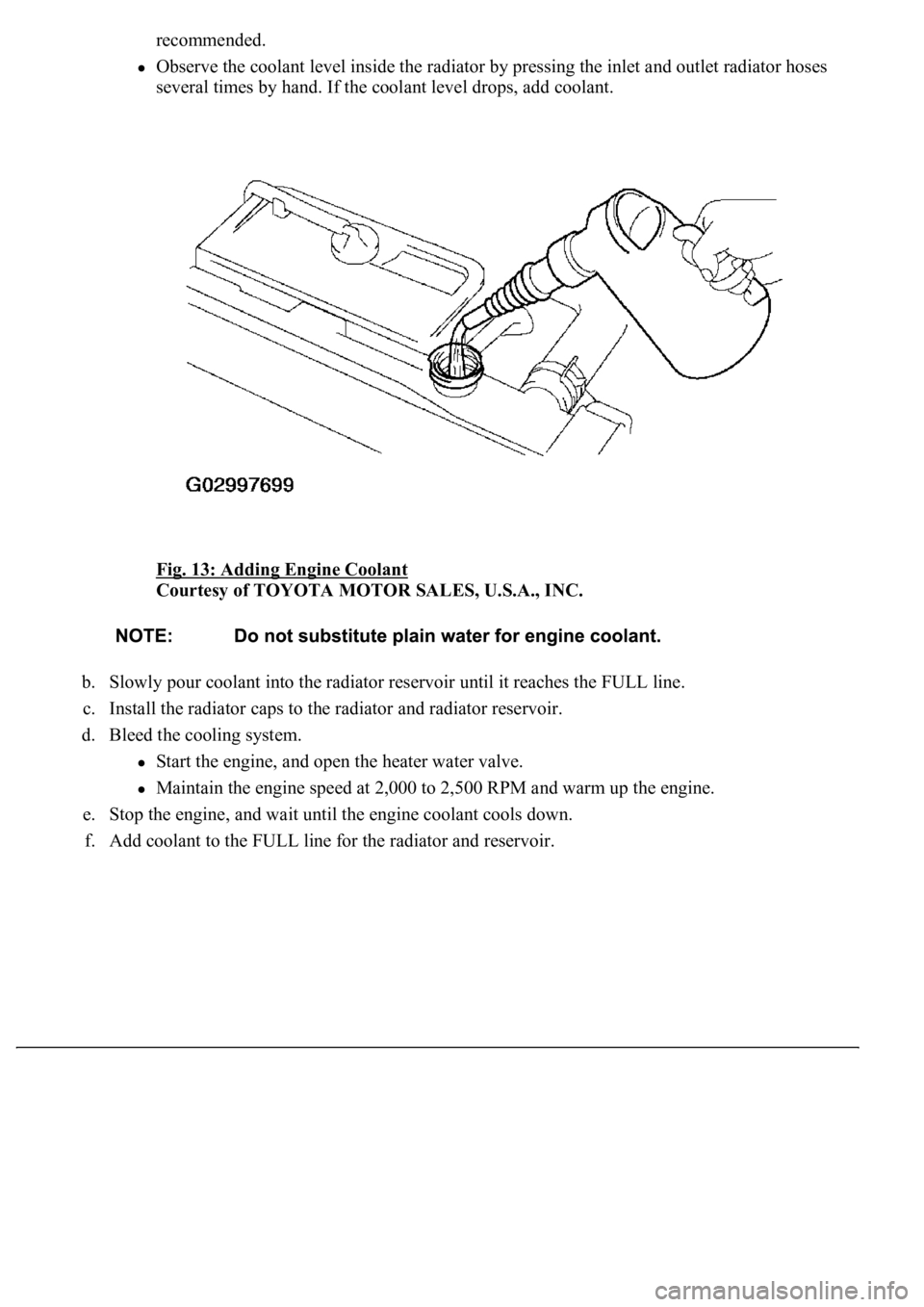Page 1 of 4500
LS430 SPECIFICATIONS INDEX
SystemSpecification/Procedure
Air Conditioning
ServiceSERVICE DATA
TorqueTORQUE SPECIFICATION
Axle Nut/Hub Nut
Front69 N.m (700 kgf.cm, 51 ft.lbf)
Rear290 N.m (2,960 kgf.cm, 214 ft.lbf)
BatteryNA
Brakes
Bleeding
SequenceBLEEDING
Disc BrakesSERVICE DATA
TorqueTORQUE SPECIFICATION
Charging
GeneratorSERVICE DATA
TorqueTORQUE SPECIFICATION
Drive Belts
AdjustmentREPLACEMENT
Belt RoutingDRIVE BELT
Engine Cooling
General Service
SpecificationsSERVICE DATA
Radiator Cap
PressureStandard Value
93 to 123 kPa (0.95 to 1.25 kgf/cm
2 , 13.5 to 17.8 psi)
Minimum Standard Value
78 kPa (0.8 kgf/cm
2 , 11.4 psi)
Thermostat R & ITHERMOSTAT
Water Pump R &
IWATER PUMP
Engine Mechanical
CompressionSERVICE DATA
Oil Pressureat idle, 29 kPa (0.3 kgf.cm2 , 43 psi) or more
at 3,000 rpm, 294 to 588 kPa (3.0 to 6.0 kgf.cm
2 , 43 to 85 psi)
OverhaulSERVICE DATA
TorqueTORQUE SPECIFICATION
Page 1849 of 4500
ON-VEHICLE INSPECTION
1.CHECK COOLING SYSTEM FOR LEAKS
a. Fill the radiator with coolant and attach a radiator cap tester.
Fig. 1: Checking Cooling System For Leaks
Courtesy of TOYOTA MOTOR SALES, U.S.A., INC.
b. Warm up the engine.
c. Using a radiator cap tester, increase the pressure inside the radiator to 137 kPa (1.4 kgf/cm
2, 19.9
Page 1850 of 4500

psi), and check that the pressure does not drop.
If the pressure drops, check the hoses, radiator and water pump for leaks. If no external leaks are found,
check the heater core, cylinder block and head.
2.CHECK ENGINE COOLANT LEVEL AT RESERVOIR
a. Check that the engine coolant level is between the LOW and FULL lines when the engine is cold.
If the engine coolant is low, check for leaks and add "TOYOTA Super Long Life Coolant" to the
FULL line.
If "TOYOTA Super Long Life Coolant" is not available, use a similar high quality ethylene glycol
based non-silicate, non-amino, non-nitrite and non-borate coolant with long-life hybrid organic acid
technology. Do not substitute plain water for engine coolant.
3.CHECK ENGINE COOLANT QUALITY
a. Remove the radiator cap.
b. Check if there are any excessive deposits of rust or scale around the radiator cap and radiator filler
hole, Also, the coolant should be free from oil.
HINT:
If excessively dirty, clean the coolant passage and replace the coolant.
c. Reinstall the radiator cap.
INSPECTION
1. INSPECT THERMOSTAT
HINT:
The thermostat is stamped with the valve openin
g temperature.
Page 1854 of 4500
Fig. 4: Checking Valve Lift
Courtesy of TOYOTA MOTOR SALES, U.S.A., INC.
2.INSPECT RADIATOR CAP SUB-ASSY
Page 1855 of 4500
a. Using a radiator cap tester, slowly pump the tester and check that air is being released from the
vacuum valve.
Fig. 5: Measuring Relief Valve Opening Pressure
Courtesy of TOYOTA MOTOR SALES, U.S.A., INC.
Pump speed: 1 push every 3 seconds or more
If air is not coming from the vacuum valve, replace the reservoir cap.
b. Pump the tester and measure the relief valve opening pressure.
Pump speed: 1 push within 1 second
Standard opening pressure:
Page 1862 of 4500
Fig. 11: Measuring resistance of switch
Courtesy of TOYOTA MOTOR SALES, U.S.A., INC.
REPLACEMENT
1.REMOVE V-BANK COVER
2.REMOVE AIR CLEANER INLET NO.1 (See REPLACEMENT
)
3.DRAIN ENGINE COOLANT
a. Remove the 2 radiator caps from the radiator reservoir and radiator.
b. Loosen the radiator drain plug and 2 drain cock plugs, then drain the coolant.
Page 1863 of 4500
c. Close the radiator drain plug.
d. Tighten the 2 drain cock plugs.
Torque: 13 Nm (130 kgf cm, 9 ft lbf)
Fig. 12: Loosening Radiator Drain Plug And Drain Cock Plugs
Courtesy of TOYOTA MOTOR SALES, U.S.A., INC.
4.ADD ENGINE COOLANT
a. Slowly fill the cooling system with coolant.
Capacity: 9.5 liters (10.0 US qts, 8.4 lmp. qts)
HINT:
Use of improper coolants may damage the engine cooling system.
Use "TOYOTA Super Long Life Coolant" or similar high quality ethylene glycol based non-
silicate, non-amine, non-nitrite, and non-borate coolant with long-life hybrid organic acid
technology.
New Toyota vehicles are filled with TOYOTA Super Long Life Coolant (color is pink,
premixed ethylene-glycol concentration is approximately 50 % and freezing temperature is -
35° C (-31° F)). When replacing coolant, TOYOTA Super Long Life Coolant is
Page 1864 of 4500

recommended.
<003200450056004800550059004800030057004b00480003004600520052004f0044005100570003004f004800590048004f0003004c00510056004c0047004800030057004b00480003005500440047004c004400570052005500030045005c0003005300
55004800560056004c0051004a00030057004b00480003004c[nlet and outlet radiator hoses
several times by hand. If the coolant level drops, add coolant.
Fig. 13: Adding Engine Coolant
Courtesy of TOYOTA MOTOR SALES, U.S.A., INC.
b. Slowly pour coolant into the radiator reservoir until it reaches the FULL line.
c. Install the radiator caps to the radiator and radiator reservoir.
d. Bleed the cooling system.
Start the engine, and open the heater water valve.
<00300044004c005100570044004c005100030057004b0048000300480051004a004c0051004800030056005300480048004700030044005700030015000f00130013001300030057005200030015000f001800130013000300350033003000030044005100
470003005a00440055005000030058005300030057004b0048[ engine.
e. Stop the engine, and wait until the engine coolant cools down.
f. Add coolant to the FULL line for the radiator and reservoir.